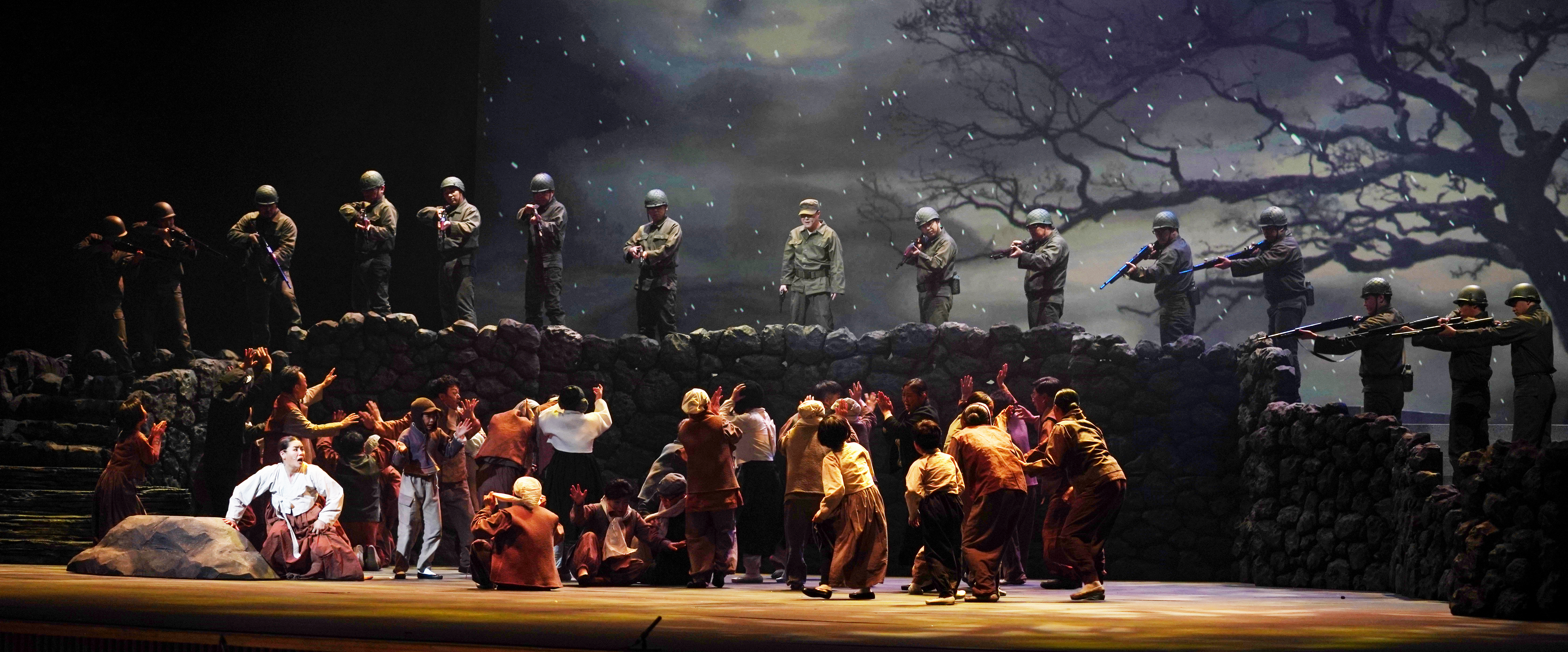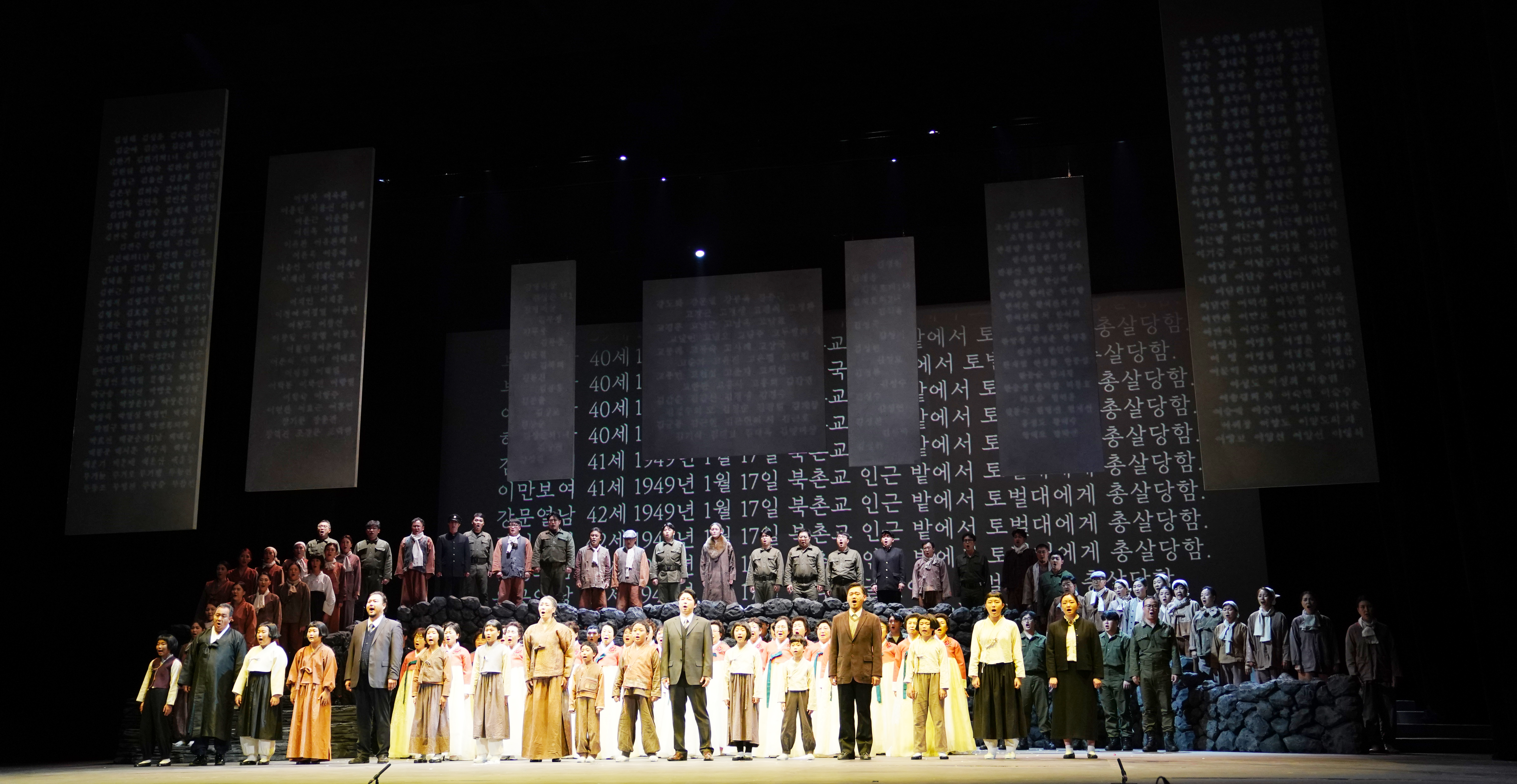The dark-red tears become the blossoms of peace
A four-act masterpiece delivering excellent music, production, and cast
Lee Eun-yeong, Publisher of The Seoul Culture Today

[Kang Hye-myeong, a general director of the creative opera, “Sun-i Samch’on”, and the soprano for the role of Sun-i Samch’on]
‘On April 3rd, or March 18th by the lunar calendar, camellia flowers were filled with dark red blood in their yellowish stamens. Tragic events happened over many days, and in many places, throughout the island of Jeju.’ This was an awakening phrase after viewing “Sun-i Samch’on,” a creative opera about Jeju 4·3. From Sept. 3 to 4, the opera, which originated from the same-name novel by Hyun Ki-young, transferred the pains of the Jeju 4·3 incident to the audience. It was when the painful, inconvenient facts of Jeju 4·3, which had been treated as no more than inevitable collateral damage caused by ideological war, were artistically described to the audience. Viewers left the concert hall with tears in their eyes. Some reported that the performance was a moving experience.
The four-act opera is about the sadness of a mother who lost her son in a mass killing that was committed by counterinsurgency forces that overran the village of Bukchon-ri, Jocheon-myeon, Jeju, in 1948. Including the Jeju Philharmonic Symphony, the Jeju Choir, the Jeju 4·3 Peace Choir (comprised of family members of Jeju 4·3 victims, Garam (theater company), Milmulhyeon (dance company), Club Jaja (children’s club), and more joined. About 230 people participated in the performance. Major arias including, ‘Eojina,’ ‘We Strive to Live Anyway,’ ‘Dead Village, Now and Then,’ and the choir sang the prologue ‘Song of the Nameless’.
The artworks of painter Kang, Yo-bae, who is famous for informing about the resistant history of Jeju 4·3 and who is a representative painter of Jeju, were also inserted in the background and intermissions of the opera. In the 1980s, Kang first read Hyun Ki-young’s novel when the artist began drawing the illustrations of the novelist’s series, ‘The Island in the Wind,’ in the Hankyoreh. In an interview, Kang told me several years ago that “The Jeju 4·3 resistance came to me as a shock.” Kang advertised Jeju 4·3 by opening serial exhibitions about the incident in 1995. It was meaningful that Kang participated in this opera as well.

[Jeju 4·3 Peace Foundation successfully held the production presentation for the opera, “Sun-i Samch’on,” at Seodaemun Prison History Hall on August 10 before its earnest performance at Sejong Center for Performing Arts in Seoul. The presentation event, with the major press, magazines, and eminent critics in Korea invited, began with a pre-ceremonial performance by cast members. On the outdoor field of the history hall, three major arias, ‘Dead Village, Now and Then,’ ‘Eojina,’ and the ‘Song of the Nameless,’ were sung.]
A solo sung by Lee Jeong-won, a tenor, went, ‘A horrible pain that cannot be understood.’ The song, ‘The Memory of the Day,’ showed the concentrated pain of Jeju 4·3. The host of the performance said it was a devotion to the novelist Hyun Ki-young. It was Hyun’s efforts that made Jeju 4·3 visible when no one dared speak or write about the incident. The novelist had to suffer imprisonment, and the novel was banned. The song included the writer’s pain, agony, and desperation to inform about what the people of Jeju have suffered so far.
The novel “Sun-i Samch’on” itself holds great value in literature. The opera being faithful to the original guarantees more than half of the success. The opera reflects the novel well. It describes Jeju dialect in the script, the nature, and the life of Jeju residents at the time all contributed thanks to the arias and the setting.


[Scenes in the opera, where the counterinsurgency forces drive the villagers in Bukchon Primary School and commit a massacre at Ompangbat.]
The opera informs about the tragic beginning as Hyun gives a narration in a gentle tone. The clauses in the novel serve as an entrance into the opera.
Act I, ‘Setting Foot on the Sunny Land,’ begins with Sang-soo, the protagonist, singing the aria, ‘Dead Village, Now and Then.’ The tenor, Kim Shin-gyu, assuming the role of Sang-soo, seemed even sadder, considering that he was a member of a bereaved family himself. His aria maintained a sense of stability from Act I through Act IV. The bass, Shim Gi-bok, who assumed the role of Sang-soo’s uncle, sang, ‘A Person Dead, Long Ago,’ expressing a deep grievance.
Act II, ‘Bukchon, Between this World and the Other,’ is about the time of ordeal. The cawing of crows continues. It is an omen that the Northwest Korean Youth Association will storm the place and bring forth relentless massacres. Crows here mean the counterinsurgency forces as well. The cawing was no more than an opening to the tragedy on ‘that day.’ Children’s innocent laughter turns into a nightmare all of a sudden. The stark difference amplified the twist. In the gunfire at Ompangbat, the flapping wings of numerous crows looking for prey were chilling.

[Sun-i Samch’on, who survived the massacre, is singing the ‘Aria of frenzy.’]
The ‘Aria of Frenzy’ sung by Sun-i Samch’on as she finds her dead children, starts with a screaming tone. She could not cry out loud after seeing her children lying dead. Kang Hye-myeong, the general director who assumed the role of Sun-i Samch’on herself, demanded the songwriter tenaciously to begin performing the song from last year. The song was a masterpiece in terms of its melody and expression.
At the end of Act II, the dire aria by Choi Seung-hyeon, who assumed the role of the grandmother, sang, ‘We strive to live anyway.’ The song is about the longing and grievance to the dead and the pains of those who survived, which was also touching.
Act III, ‘The evacuation finally lifted in 1948,’ is described by two children in the beginning. Just as in the aria, ‘We Strive to Live Anyway,’ the children who survived had to move on in life. They forget the moments of terror and chant the names of their favorite food to forget about hunger, too. It was also meaningful that the opera introduced the traditional food of Jeju while simultaneously changing the dark atmosphere for a short moment. The scene leads to Ompangbat. Withstanding the whispers of the villagers, Sun-i Samch’on attends to farming while taking care of the child that had been conceived inside her. The scene describes she had to hold on to the life of her new child. The clues have been gathered as to the things Sun-i Samch’on could not understand up to the point, while she kept suffering from hallucinations. In this scene, the dance performance of the spirits who died in pain and the emergence of a flock of crows showed symbolization of the counterinsurgency forces.

[‘Song of the Nameless’ was sung by all the full cast of the opera. The names of victims are displayed here as subtitles.]
Act IV, ‘Rest Your Spirit and Soul,’ paradoxically describes that the soul of Sun-i Samch’on, already dead 30 years before, on the very day of the incident, when actually it is she takes the pill. The scene rings her death with a gunfire. The scene was connected to Moon Seok-beom’s performance, which shouts ‘wheeer—- wheeer—-’ like an animal, hanging Gimae, a symbol of one’s soul, on a blue bamboo stick. The solid representation of soul, which was combined with the dance of exorcism, was no doubt fit for expressing the resentment of the living. With the choir singing the ‘Song of the Nameless,’ the victims’ names were displayed as a backdrop in commemoration.
The opera was excellent in every aspect: the story, the development, the singers, the actors, and the music. Arias did much in presenting touching moments to the audience. The music, sound effects, ensemble, dance, and soulful performance three-dimensionally expressed terror, pain, and resentment from the forced silence. The acting and the singing were profound and had details. Sun-i Samch’on is an opera, but the musical and dramatic features were combined and stood out. In the scenes of the massacre, the singer who assumed the officer’s role was replaced by an actor, and the change worked. The acting of the officer was as cunning as it was marvelous. The baritone, Kim Seong-gook, who assumed the role of the uncle-in-law, used both the Jeju and the North Korean dialects alternately. The fact that the North Korean dialect was a traumatic to the victims’ families was well delivered in the acting. Children also played their roles well to the end. The background and set pieces were elaborately prepared. The hackberry tree at the back of Ompangbat was exemplary work. The tree represents Jeju, as it is commonly seen across the island. The sound effects and lighting raised tension and made the space look more realistic.
Nevertheless, there were some parts amiss. The use of microphones and music recorded, which are not commonly adopted in operas, and the distracting scenes in Act III were some things to be frowned upon. Also, in the lyrics of one of the arias of Sun-i Samch’on, it would have been better to explicitly say ‘my precious babies’ rather than just ‘children.’ That way, it would have been more persuasive in explaining her feeling. The same goes for the lines. There might have been other methods to deliver historic lessons. With these suggested improvements, the play would succeed as a more complete work. As was hoped by Hyeon, one can imagine the work being performed in Japan and in the United States.
When we look back at the history of the world, some places suffer similar scars. Modern history holds several incidents. It is the power of arts that reflect and remind people of events we should never forget about. I would like to root for Sun-i Samch’on on a work made through the willg of the bereaved families of the Jeju 4·3, who wish to move on to reconciliation, healing, and peace through arts. I give my sincerest respect to Hyeon Ki-young, the original writer, and all the members of the staff and cast who have done so much for the work.